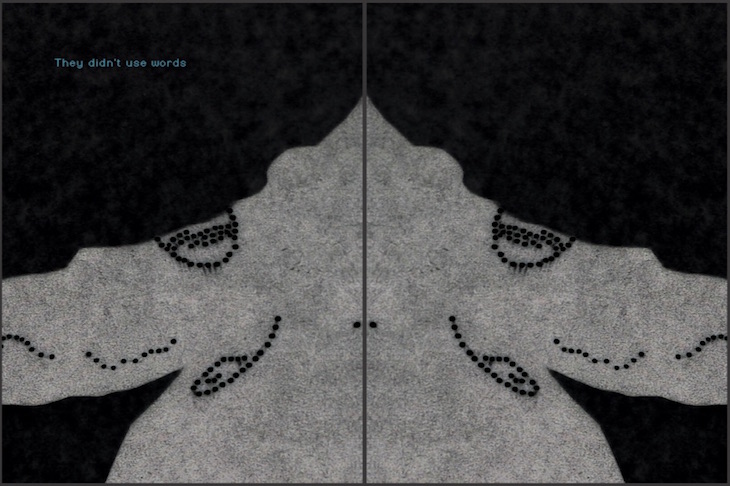Elizabeth Price’s latest work continues her long-standing fascination with codes of female dress and the animating power of gesture. However, txtʃərz, a video piece installed in the gallery of the adult education centre Morley College, is ostensibly not about either of these things but about the current crisis in UK higher education. In a story narrated by a single, computer-generated voice, the work describes a fictional scenario in which a group of former academics elect to stop speaking words. Whilst the majority of the group are entirely mute, some of them continue producing vocal sounds, chief amongst which is the term by which they refer to themselves: the phrase is rendered as ‘txtʃərz’ in one phonetic script, translated by the press, we are told, as ‘teachers’ and pronounced by the machine-narrator as ‘textures’.
Film still from txtʃərz (2018) by Elizabeth Price, installed at the Morley Gallery (5–14 July). Courtesy Morley Gallery, London
This point forms a characteristically Pricean branch in the structure of the piece: if the group’s endonym is read as ‘teachers’, then the work coheres into a satirical commentary on the evisceration of the university as a model for the production and passing-on of knowledge across generations. Indeed, the narrative identifies the original founders of the group – who gain notoriety for the bizarre and profane rituals they adopt in place of speech – as members of a ‘national advisory committee for higher education’ who one day ‘just fell silent’. This satire is given its edge by the exhibition’s timing, mere months since university staff launched some of the largest strikes in the history of British higher education, following attempts by the employers’ body to radically undercut their pensions. As academics have argued, this pension dispute should not be seen as an isolated instance, but as a key battleground in the move to marketise higher education as a whole, replacing the vision of education as a public good with a narrowly instrumental one.
Film still from txtʃərz (2018) by Elizabeth Price, installed at the Morley Gallery (5–14 July). Courtesy Morley Gallery, London
Reading the group’s name as ‘textures’ opens up other, less overt aspects of the work. The video’s visuals, behind the typed words which fill the double screen as the narrator speaks, consist of black-and-white abstracted shapes, lines and punched holes, which open and close in mirrored arrays. These images originate in Price’s collection of women’s fashion photography from the 1960s to the 1980s; she was interested, she told me when we discussed the work, in the gestures that the models had to make to activate the garments’ features, their pleats and sleeves. This broadened into an interest in the excesses of other kinds of ritual robes: legal, ecclesiastical and academic.
Film still from txtʃərz (2018) by Elizabeth Price, installed at the Morley Gallery (5–14 July). Courtesy Morley Gallery, London
A fascination with the power of gesture to animate, even to resurrect, is a significant feature of much of Price’s work: the twisting bodies of sepulchral effigies play a crucial hinging role in The Woolworths Choir of 1979 (2012; currently on display within walking distance of the Morley Gallery at Tate Britain), where they permit a transition from funerary monuments to the dancing figures of a chorus of ’60s pop singers; gesture also powered the stunning movement from images of prone bodies (sleeping, working, mourning) to vertical, dancing ones in the fourth section of ‘In a Dream You Saw a Way to Survive and You Were Full of Joy’, the exhibition Price curated for Hayward Touring in 2016–17.
Film still from txtʃərz (2018) by Elizabeth Price, installed at the Morley Gallery (5–14 July). Courtesy Morley Gallery, London
In txtʃərz, the activating gesture that moves the garment-based patterns is a repeated action of opening and closing, inescapably reminding the viewer of a book. Here the subterranean research process behind the visuals erupts into the overt narrative of the story: one researcher, we are told, believed that the group’s phonations were never intended to be words, but instead were derived from the sounds of their workplace: the ‘rustle of papers’, ‘clatter of keyboards’, and above all, the ‘opening and closing of a big, ancient, book’. If this book is to be re-opened, Price’s work suggests, it will be thanks to the resurrectory power of the unruly, disobedient gesture.
Elizabeth Price photographed in her studio. Courtesy the Morley Gallery, London
txtʃərz by Elizabeth Price is at the Morley Gallery, London, until 14 July.
